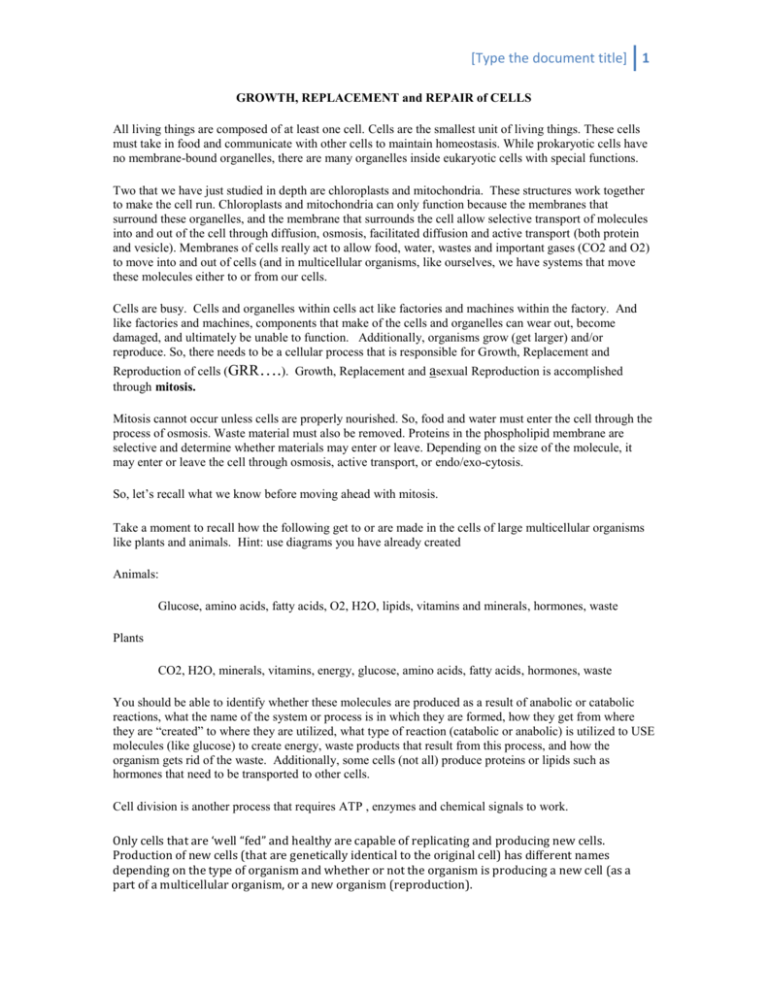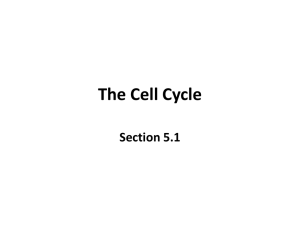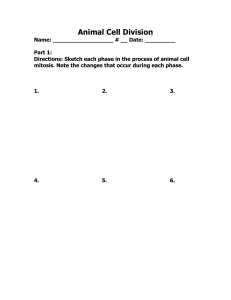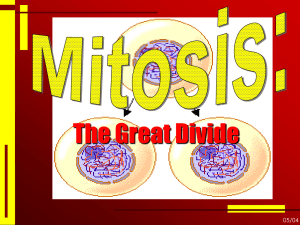C GROWTH, REPLACEMENT and REPAIR of CELLS All living
advertisement

[Type the document title] 1 GROWTH, REPLACEMENT and REPAIR of CELLS All living things are composed of at least one cell. Cells are the smallest unit of living things. These cells must take in food and communicate with other cells to maintain homeostasis. While prokaryotic cells have no membrane-bound organelles, there are many organelles inside eukaryotic cells with special functions. Two that we have just studied in depth are chloroplasts and mitochondria. These structures work together to make the cell run. Chloroplasts and mitochondria can only function because the membranes that surround these organelles, and the membrane that surrounds the cell allow selective transport of molecules into and out of the cell through diffusion, osmosis, facilitated diffusion and active transport (both protein and vesicle). Membranes of cells really act to allow food, water, wastes and important gases (CO2 and O2) to move into and out of cells (and in multicellular organisms, like ourselves, we have systems that move these molecules either to or from our cells. Cells are busy. Cells and organelles within cells act like factories and machines within the factory. And like factories and machines, components that make of the cells and organelles can wear out, become damaged, and ultimately be unable to function. Additionally, organisms grow (get larger) and/or reproduce. So, there needs to be a cellular process that is responsible for Growth, Replacement and Reproduction of cells (GRR….). Growth, Replacement and asexual Reproduction is accomplished through mitosis. Mitosis cannot occur unless cells are properly nourished. So, food and water must enter the cell through the process of osmosis. Waste material must also be removed. Proteins in the phospholipid membrane are selective and determine whether materials may enter or leave. Depending on the size of the molecule, it may enter or leave the cell through osmosis, active transport, or endo/exo-cytosis. So, let’s recall what we know before moving ahead with mitosis. Take a moment to recall how the following get to or are made in the cells of large multicellular organisms like plants and animals. Hint: use diagrams you have already created Animals: Glucose, amino acids, fatty acids, O2, H2O, lipids, vitamins and minerals, hormones, waste Plants CO2, H2O, minerals, vitamins, energy, glucose, amino acids, fatty acids, hormones, waste You should be able to identify whether these molecules are produced as a result of anabolic or catabolic reactions, what the name of the system or process is in which they are formed, how they get from where they are “created” to where they are utilized, what type of reaction (catabolic or anabolic) is utilized to USE molecules (like glucose) to create energy, waste products that result from this process, and how the organism gets rid of the waste. Additionally, some cells (not all) produce proteins or lipids such as hormones that need to be transported to other cells. Cell division is another process that requires ATP , enzymes and chemical signals to work. Only cells that are ‘well “fed” and healthy are capable of replicating and producing new cells. Production of new cells (that are genetically identical to the original cell) has different names depending on the type of organism and whether or not the organism is producing a new cell (as a part of a multicellular organism, or a new organism (reproduction). Binary Fission Prokaryotic organisms are single celled, with no nucleus. Cyanobacteria are small prokaryotes that can photosynthesize. They divide via a process termed binary fission. Binary fission involves the following steps: 1. 2. 3. The cell grows The cell then duplicates its single circular chromosome The cell grows again, increasing the distance between the duplicated chromosomes 4. The cells divide by creating new cell walls, which begin as a structure called the septum. EVOLUTIONARY NOTE: Chloroplasts share many similarities with Cyanobacteria. Chloroplasts are organelles in plant cells that can photosynthesize, contain their own DNA and ribosomes and divide via binary fission. The similarity of chloroplasts to cyanobacteria provides evidence for the theory of endosymbiosis, which is an explanation for how eukaryotes may have “formed”. Eukaryotic Reproduction Eukaryotes are much larger than prokaryotes and have many organelles. Besides organelles like chloroplasts and mitochondria, a key differentiator between prokaryotic and eukaryotic cells is the presence of a nucleus. The nucleus is a “container” for DNA. Remember that even the nucleolus (which creates ribosomes) is a specialized area of DNA that includes proteins and rRNA and is responsible for the formation of ribosomes. So, in order to create a copy of a eukaryotic cell, a copy of the DNA must be created first. This step is called replication. This happened in the prokaryotic cell as well. But the prokaryotic cell has only a single circular strand of DNA. Eukaryotic cells can have many linear strands of DNA (we happen to have 46). Because of the length and number of DNA strands, copying the DNA and ensuring a copy of each strand of DNA goes into each cell is a more difficult process than replicating a single circular chromosome. In eukaryotes, the organization and the separation of these replicated strands of DNA into two groups of identical DNA is termed mitosis. Mitosis involves coiling the replicated DNA into structures called duplicated chromosomes and dissolving the nuclear membrane (prophase), moving these structures to the center of the cell (metaphase) and then splitting each duplicated chromosome to form two “unduplicated” chromosomes (anaphase). These structures are moved to opposite ends of the cell, and a nuclear membrane forms around each of the two sets of chromosomes (telophase). This signals the end of mitosis. [Type the document title] 3 In many cells the cell membrane divides (cytokinesis) either during or immediately after telophase and the cell moves back into interphase until it is again ready to divide. In some cells (like muscle cells) cytokinesis does not occur and the cell becomes longer with multiple nuclei. Draw a picture of the cell cycle below. You must include interphase (and its three “subphases), mitosis and cytokinesis as a cycle, with appropriate amounts of the circle allocated to each diagram. Then draw a representative picture of each stage of mitosis (use website below, next page or the book) http://highered.mheducation.com/sites/0072495855/student_view0/chapter2/animation__how_the_cell_cycle_works.html Cell cycle Stage of Mitosis (Draw/Label) Description Cell Cycle and Cancer. https://www.youtube.com/watch?annotation_id=annotation_4012916109&feature=iv&src_vid=gwc wSZIfKlM&v=lpAa4TWjHQ4. The cell cycle has many checkpoints to ensure the DNA is being copied and divided correctly. Use the questions attached to this handout (and the cartoon video above) to explore the link between the cell cycle and cancer. If you are having trouble understanding the phases of mitosis, view the second video (below) and use the notes sheet for the second video to help to identify the key stages of mitosis. https://www.youtube.com/watch?v=JcZQkmooyPk [Type the document title] 5 QUESTIONS – CANCER and THE CELL CYCLE 1. There are many types of cancer. But this video identifies one underlying cause of all cancers. What is it? 2. What are factors that can contribute to or increase your risk of cancer? 3. Is cancer contagious? 4. All cells in your body are in one of two phases which are a. _______________________________ or b. _________________________________ Most somatic (body) go through a cell cycle. This cycle is listed as having either 2 (interphase and mitosis) or 3 (interphase, mitosis, cytokinesis) major phases. This video divides the cell cycle into two phases, interphase and mitosis. We will be dividing the cell cycle into THREE phases. 5. What could the cell be doing during interphase (list three things). 6. During mitosis, the DNA found within the nucleus replicates. The cell then divides (a process called cytokinesis). 7. What percent of a cell’s life (on average ) is spent in interphase? How much time in mitosis? 8. Do all cells divide at the same rate? Provide an example of a human cell that divides rapidly, what about one that never divides? 9. What is a disadvantage of having cells that don’t divide? 10. Provide three reasons that mitosis is important 11. What is the purpose of a cell cycle checkpoint? What occurs when a cell fails the checkpoint? 12. Why is “self-destruction” a good thing? 13. How is cancer cell division different from “normal” cell division? 14. Go back to question 2, and add to your list of risk factors. 15. What type of cell is targeted by chemotherapy? Can “normal cells” be impacted by chemotherapy? Explain. 16. What happens if cancer cells are able to produce growth hormone? (be sure to get all the details? 17. New chemotherapies are able to specifically target key processes, such as hormone production, or to target key mutations (DNA/RNA sequences) which help cancer to divide and grow. Why is it helpful to develop medications that have specific targets (rather than just kill rapidly growing cells). End of video 1








